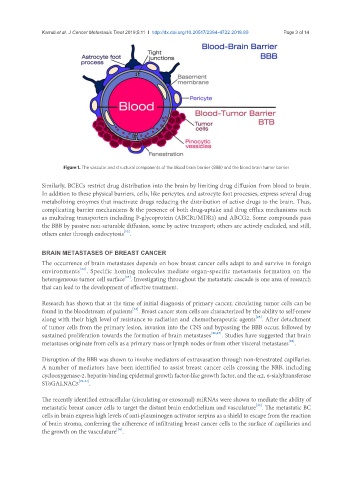Page 161 - Read Online
P. 161
Kamal et al. J Cancer Metastasis Treat 2019;5:11 I http://dx.doi.org/10.20517/2394-4722.2018.89 Page 3 of 14
Figure 1. The vascular and structural components of the blood brain barrier (BBB) and the blood brain tumor barrier
Similarly, BCECs restrict drug distribution into the brain by limiting drug diffusion from blood to brain.
In addition to these physical barriers, cells, like pericytes, and astrocyte foot processes, express several drug
metabolizing enzymes that inactivate drugs reducing the distribution of active drugs to the brain. Thus,
complicating barrier mechanisms & the presence of both drug-uptake and drug efflux mechanisms such
as multidrug transporters including P-glycoprotein (ABCB1/MDR1) and ABCG2. Some compounds pass
the BBB by passive non-saturable diffusion, some by active transport; others are actively excluded, and still,
[12]
others enter through endocytosis .
BRAIN METASTASES OF BREAST CANCER
The occurrence of brain metastases depends on how breast cancer cells adapt to and survive in foreign
[22]
environments . Specific homing molecules mediate organ-specific metastasis formation on the
[23]
heterogeneous tumor cell surface . Investigating throughout the metastatic cascade is one area of research
that can lead to the development of effective treatment.
Research has shown that at the time of initial diagnosis of primary cancer, circulating tumor cells can be
[24]
found in the bloodstream of patients . Breast cancer stem cells are characterized by the ability to self-renew
[25]
along with their high level of resistance to radiation and chemotherapeutic agents . After detachment
of tumor cells from the primary lesion, invasion into the CNS and bypassing the BBB occur, followed by
sustained proliferation towards the formation of brain metastases [26,27] . Studies have suggested that brain
[28]
metastases originate from cells as a primary mass or lymph nodes or from other visceral metastases .
Disruption of the BBB was shown to involve mediators of extravasation through non-fenestrated capillaries.
A number of mediators have been identified to assist breast cancer cells crossing the BBB, including
cyclooxygenase-2, heparin-binding epidermal growth factor-like growth factor, and the α2, 6-sialyltransferase
ST6GALNAC5 [29-34] .
The recently identified extracellular (circulating or exosomal) miRNAs were shown to mediate the ability of
metastatic breast cancer cells to target the distant brain endothelium and vasculature . The metastatic BC
[35]
cells in brain express high levels of anti-plasminogen activator serpins as a shield to escape from the reaction
of brain stroma, conferring the adherence of infiltrating breast cancer cells to the surface of capillaries and
[36]
the growth on the vasculature .

